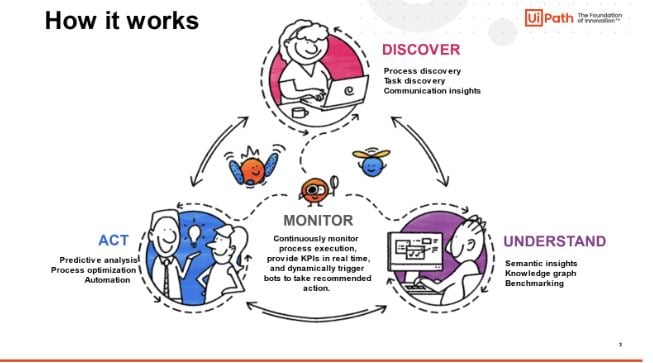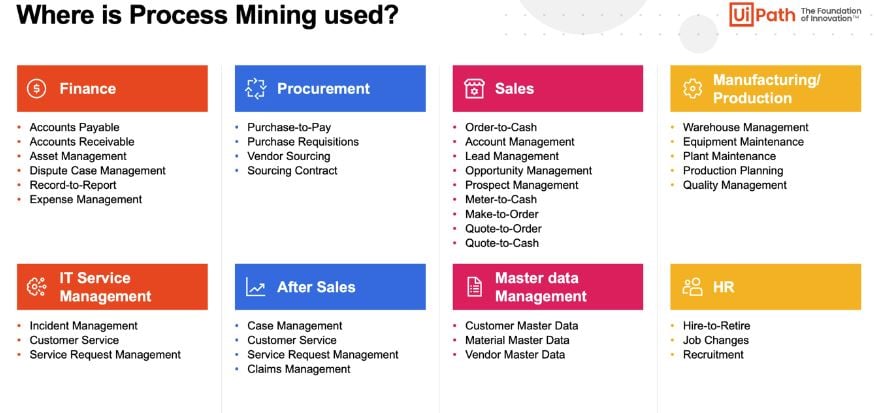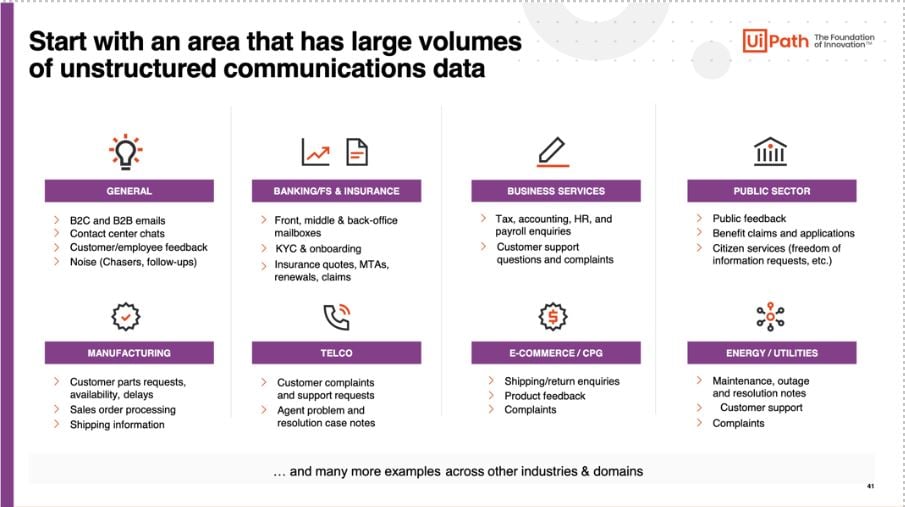Getting Started with Continuous Discovery
Share at:

Introduction
In a previous blog post, we delved into how customers are using Continuous Discovery to boost the outcomes of their automation initiatives. But how can organizations start embedding Continuous Discovery into their automation program? Where and how do you start?
We’ll cover all of that in today’s blog post. First, a quick recap of Continuous Discovery. Continuous Discovery enables you to discover, understand, act, and track your business processes. It’s all about adding value to your automation and process improvement efforts. The approach is supported by discovery and automation technologies, process mining, task mining, communications mining, and idea capture and management.
Why is Continuous Discovery important?
It’s key to business resilience.
Continuous Discovery calls for—and enables—strict prioritization and scientific optimization of processes. This is key to building organizational resiliency, enabling you to make changes, discover new improvements, and monitor impact while transforming your processes. The difference between world-class organizations and the rest is the degree to which they embrace automation and practice concepts such as Continuous Discovery. Jesus Kallergis, Product Marketing Manager, UiPath
There are multiple entry points UiPath provides. It’s also the only platform that allows you to mine process data, desktop interactions, and communications such as emails.

So, do you start with the solution or the problem? We recommend starting with the biggest pains in your processes. We commonly see customers struggling with four different issues:
Finding high-ROI process automation/improvement ideas
Improving or automating service conversations
Identifying repetitive tasks for automation
Building a business case to prioritize the most impactful ideas and get buy-in for automation/improvement initiatives.
For each of these issues, UiPath provides a solution. Before proceeding with the solution, we recommend evaluating the business value, the team involved, and the technical aspects of the process.
Struggling to find high-ROI process automation/improvement ideas?
Process owners may struggle with transparency in their end-to-end business processes. Specifically, they face challenges identifying bottlenecks, inefficiencies, and instances of non-compliance within these processes, including how work transitions from one team to another. Process mining addresses this need by extracting valuable insights from business applications (ERP, CRM, workflow systems) that leave behind transactional traces. Read more about UiPath Process Mining.

We recommend starting with one of the following processes:
Purchase-to-pay
Order-to-cash
Lead-to-order
Incident management
Warehouse management
Why? First off, these financial, manufacturing, and IT processes are the ones that customers most often struggle with, and improving these processes provides a lot of business value due to their impact. Secondly, they span multiple departments and have a high transaction volume. That’s why these are available as app templates, pre-configured dashboards, and KPIs, to ensure you can spend more time analyzing and acting on the insights. If you are eager to discover another process, we have three aspects that allow our customers to get the most success:
When the desired outcome is to automate/improve the process.
They experience negatively impacted KPIs.
The process is executed daily and across large or multiple departments.
After assessing business value, it’s crucial to ensure that you have the right team characteristics. This should include process experts, technical experts, and securing buy-in from stakeholders to facilitate process changes. If your process and system of record are listed in the image above, the technical requirements are validated. If your process is not covered by our templates, we can still connect Process Mining to your processes. Just ensure that your system allows for data extraction and verify that the data can provide the input for an event log as outlined on our documentation. This paves the way for your first Process Mining project.
Struggling to improve/automate service conversations?
Communications channels such as emails, service tickets, and reviews are difficult for traditional discovery approaches to process, given the large quantities of unstructured conversational data. Yet they contain a wealth of valuable insights and a substantial amount of work is triggered by communications. In business, every message is a problem to be solved or an opportunity to be discovered.
Fortunately, UiPath Communications Mining provides visibility into these channels by understanding and extracting the intent and sentiment of communications. It uses state-of-the-art AI (artificial intelligence) which you can finetune to your exact business needs. Read more about Communications Mining.

The above visual shows common industry processes that depend on large flows of communications. This is not an exhaustive list, but they are the most common scenarios where we see UiPath customers getting value from Communications Mining.
Consider the following when identifying the value of Communications Mining within your own organization. First off, determine if your goal is analyzing the process and or automating communications processing by extracting structured data from messages. Secondly, there should be lots of employees spending a large amount of time processing communications from the channel. Lastly, the annual message volume the team deals with should be above 50 thousand, but ideally in the hundreds of thousands or even millions.
There are some further technical considerations. Check that communication is done primarily through emails or tickets, and that the team’s time is mainly spent on the manual routing of requests or answering transactional communications (ones that only require a few messages to resolve). Finally, it will be easier to extract the data if the communications are captured in a CRM system or a centralized mailbox. This sets you up with the right scope for your first Communications Mining project.
Struggling to identify/document repetitive tasks for automation?
Filling up the pipeline requires knowing what repetitive steps are taking place in the process. Yet CoEs may struggle with the lack of visibility in how the work is performed by the people in the process. UiPath Task Mining gives you that visibility. Read more about Task Mining.
The above visual shows the areas where customers are usually deploying Task Mining. If you have a candidate project, check for the following conditions to guarantee you are on track to get value out of it. First, check if the outcome is to automate or streamline the process with operational changes. Secondly, provide multiple people are doing similar tasks. Lastly, make sure there is a high degree of routine in the target process.
For a smooth project, socialize the benefits of capturing data from each team member. Explain what is being captured and how streamlining this effort will benefit each user. The recorder sits on a user’s desktop, which means that some technical prerequisites need to be met. More on the firewall setup and machine specifications can be found on our documentation page. This sets you up with the right expectations to embark on your first Task Mining study, supporting you in your Continuous Discovery journey.
Struggling to get buy-in from executive leadership for automation/improvement initiatives?
As automation initiatives mature into programs, CoEs often struggle with filling up their automation pipeline (with impactful ideas), effectively prioritizing initiatives, and reporting on the impact of their automations. This is where Automation Hub comes into play.
We see that customers get value from Automation Hub regardless of whether they capture improvement ideas through mining or crowdsourcing. They can effectively prioritize and implement faster (this use case describes how speeds of 20x are reached). This boosts the maturity of the automation program as the impact increases and the CoE also has more accurate information to report to their executive leadership.
Typically, the CoE rolls out Automation department by department, often starting with the domains that are also prevalent in the examples listed above for the other solutions. Use this video demonstration to educate your business users and review this video series on best practices to kick off scaling your automation program.
Conclusion
Note that to establish the value of each solution, we first identify the objective. If the objective does not align, another mining product may help. In other cases, multiple UiPath products are used together to come to a holistic solution, i.e. using both Communications Mining and Process Mining to understand different aspects of the same process.
Which Continuous Discovery solutions can I get started with today? If you’re eager to know what you already own, you can validate this by navigating to the customer portal. This will show you which licenses you already have allocated. Most customers already have access to Automation Hub allowing them to track the lifecycle of their automation ideas. Any purchase of AI units gives you access to Task Mining as well. Our website has more information about the entire UiPath platform. You can also contact your sales expert directly or via our contact page.
Discovery Sales Engineer, UiPath
Get articles from automation experts in your inbox
SubscribeGet articles from automation experts in your inbox
Sign up today and we'll email you the newest articles every week.
Thank you for subscribing!
Thank you for subscribing! Each week, we'll send the best automation blog posts straight to your inbox.



